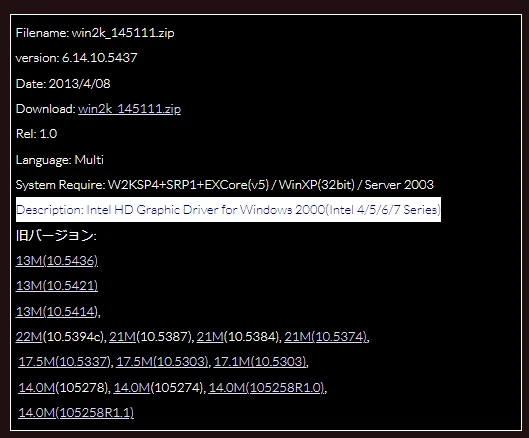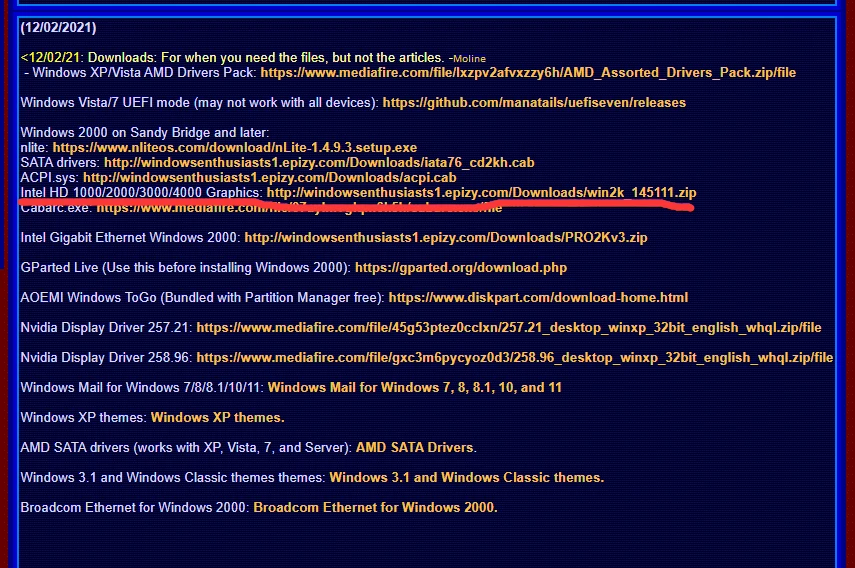推荐本站淘宝优惠价购买喜欢的宝贝:
你还在为在VBox里的win9x装不上显卡驱动程序而发愁吗?你还在为Windows Me在Bochs里无法正确识别显卡而忍受着辣眼的16色吗?
它,来了!
通用的VESA VBE显卡驱动,让你远离win9x中辣眼的16色!
How to install?
===================
挂载光驱,点开设备管理器,安装驱动(CDROM\VBE9X\UNI\vbemp.inf)
如果有安全问题,跳过即可
重新启动计算机
Enjoy it!:)
====================
以下是实战图片[?],[?]
Windows 9x clones - ALL of them
Release version beta
2014.01.31
Universal VBE20 version. *
Windows 9x clones - ALL of them
Release, debug version pre-beta
2010.06.01
Universal VBE20 version. *
Windows 9x clones - ALL of them
Release, debug version pre-beta
2008.10.21
Universal VBE20 version. *
Windows 9x clones - ALL of them
Release version pre-beta
2008.03.23
Universal/Manual VBE20 version. *
Windows 9x clones - ALL of them
Original source code
FRAMEBUF sample from Windows 9x DDK. Compile it with MASM 6.x.
http://www.mdgx.com/add.htm#DDK
* If universal version does not work with your card, you may try Manual version. To get it you should contact me by e-mail & send me report generated by INFOVBE.EXE, so I could send you personal driver for your video card by e-mail.
Installation note 0: Current driver unsolved problems:
Slow driver operation when user scroll, move or resize a window.
Locking and garbage problems when entering DOS WDM or console session.
Garbage problems when displaying text with some screen fonts.
Do not ask me about it, just wait for next driver release, which date is TBD.
Installation note 1: If you are experiencing problems while installing my driver read article below. Details here: MSKB: How to install or change a video driver (Q131806)
Installation note 2: If your card is working slowly and screen is flickering with driver installed, especially when moving large windows and scrolling texts you may improve it: go to Control Panel -> Display -> Settings tab -> Advanced button -> Troubleshooting tab and move Hardware acceleration slider to the left position (None). Details here: MSKB: How to Change the Graphics Hardware Acceleration Setting in Windows (Q263391)
Installation note 3: Starting from version dated 2008.03.16, vbemp9x.zip contains these variants of driver:
"UNIVERSAL":
\VBE9x\BASE16 - version (VBE 2.0+) for ANY cards, 8/16 bit color ONLY
\VBE9x\UNI - version (VBE 2.0+) for ANY cards
"MANUAL" (obsolete):
\VBE9x\ATI - version (VBE 2.0+) for ATI, 3dfx, Cirrus Logic, Intel740, TSENG Labs cards ONLY
\VBE9x\NV - version (VBE 2.0+) for nVidia, Riva128, Intel (845+), Trident, Matrox, S3 cards ONLY
\VBE9x\INTEL - version (VBE 2.0+) for Intel (845+) cards ONLY (experimental version)
\VBE9x\BOCHS - version (VBE 2.0+) for BochsVBE card ONLY
\VBE9x\VIRTUALBOX - version (VBE 2.0+) for VirtualBoxVBE card ONLY
\VBE9x\VMWAREII - version (VBE 2.0+) for VMWare II SVGA card ONLY
Special builds:
\VBE9x\CL54 - version (VBE 1.02) for Cirrus Logic CL-GD54xx cards ONLY
if one version is not working correctly with your card try another or vice versa....
Installation note 3: Version dated 2014.01.31 and later, 140131.zip contains these variants of driver:
"UNIVERSAL":
\128MB - version (VBE 2.0+) for ANY cards, VRAM memory limited to 128 Mb.
\064MB - version (VBE 2.0+) for ANY cards, VRAM memory limited to 64 Mb.
\032MB - version (VBE 2.0+) for ANY cards, VRAM memory limited to 32 Mb.
"MANUAL" (140214.zip):
\ATOMBIOS - version (VBE 2.0+) for AMD/ATI cards with ATOMBIOS - mostly HD series and later.
\LOGGED - debug version, produces c:\vbelog.txt, see Driver troubleshooting section below.
if one version is not working correctly with your card try another or vice versa....
Special folders:
\NOVESA - VXD driver, which prevent access to VESA modes in DOS session
\PATCH - contains GETBIOS tool, which can save binary VBIOS from memory into file, mostly named c000.rom, for modifying.
\PATCH - contains INTELDMP patcher, it can add new video modes into resident Video BIOS for some chips.
First of all, you must figure out and select what BIOS file is for your video card (it can be either EXE or DAT file), or you can use binary file, dumped by GETBIOS tool.
In example, provided below we use ALV_1411.EXE - it is for Intel 91xG (Moble).
How to use it:
Run: INTELDMP ALV_1411.EXE, it prints actual mode table from BIOS file, find one, that you can safely replace with custom mode. Remember which mode to replace and convert mode number to decimal.
Run: INTELDMP ALV_1411.EXE ALV.EXE 48 1024 600, to create a new BIOS file (ALV.EXE) from old (ALV_1411.EXE) with new mode. Note that 48 is a decimal mode number, in p.p. 1 it will be shown as 0x30 (hex).
\PATCH - contains RAMBIOS tools, which can load and activate binary VBIOS file into memory, replacing default one: rambios.com /i vbios.bin or rambios.exe vbios.bin.
\PATCH\VBIOS - contains INTEL VBIOS collection, see below:
ALM_xxxx.??? - Intel(r)830M PCI Accelerated SVGA BIOS LPG_xxxx.??? - Intel(r) 82945G Chipset Family PCI Accelerated SVGA BIOS CAL_xxxx.??? - Intel(r) 82945GM Chipset Family PCI Accelerated SVGA BIOS BDG_xxxx.??? - Intel(r)845G/845GL/845GE/845GV PCI Accelerated SVGA MTG_xxxx.??? - Intel(r)852GM/852GME/855GM/855GME PCI Accelerated SVGA BIOS SDG_xxxx.??? - Intel(r)865G PCI Accelerated SVGA BIOS GDG_xxxx.??? - Intel(r)915G/915GV/910GL PCI Accelerated SVGA BIOS ALV_xxxx.??? - Intel(r)915GM/910ML/915MS PCI Accelerated SVGA BIOS BWG_xxxx.??? - Intel(r)Q965/Q963/G965 PCI Accelerated SVGA BIOS CRL_xxxx.??? - Intel(r)GM965/PM965/GL960 PCI Accelerated SVGA BIOS BLB_xxxx.??? - Intel(r)Q33/Q35/G33 PCI Accelerated SVGA BIOS PNV_xxxx.??? - Intel(r)PineView PCI Accelerated SVGA BIOS (mobile GMA3150) CTG_xxxx.??? - Intel(R)Cantiga PCI Accelerated SVGA BIOS (mobile G4x) ELK_xxxx.??? - Intel(R)Eaglelake PCI Accelerated SVGA BIOS (desktop G4x) ILD_xxxx.??? - Intel(R)Ironlake Desktop PCI Accelerated SVGA BIOS (desktop HD Graphics, 5 gen.) ILM_xxxx.??? - Intel(R)Ironlake Mobile PCI Accelerated SVGA BIOS (mobile HD Graphics, 5 gen.) SND_xxxx.??? - Intel(R) Sandybridge/Ivybridge PCI Accelerated SVGA BIOS (desktop HD/HD2000/HD2500/HD3000 Graphics) SNM_xxxx.??? - Intel(R) Sandybridge/Ivybridge PCI Accelerated SVGA BIOS (mobile HD/HD2000/HD2500/HD3000 Graphics) HSW_xxxx.??? - Intel(R) HSW Mobile/Desktop PCI Accelerated SVGA BIOS (desktop/mobile Haswell HD4000 Graphics) PLS_xxxx.??? - Intel(r)Poulsbo PCI Accelerated SVGA BIOS (mobile GMA500)
Installation note 3: By default any Plug'N'Play video cards will be detected CORRECTLY by 9x version of my driver. But if you wish, you MAY add your video card's PCI VENDOR/DEVICE ID in vbemp.inf so your card will named as it is or you can select the driver manually when Windows firstly find an unknown device. This is an optional operation!
Sample:
; INF file for VBE display driver ; Copyright 2004-2014, Anapa Corp. [version] Class=DISPLAY signature="$CHICAGO$" Provider=%Mfg% . . . . . . . . . . . . [Mfg] %AnaPa.DeviceDesc%%AnaPa.DeviceDesc1% = PCIVID, PCI\CC_0300 %AnaPa.DeviceDesc%%AnaPa.DeviceDesc2% = PCIVID, PCI\CC_0301 %AnaPa.DeviceDesc%%AnaPa.DeviceDesc3% = PCIVID, PCI\CC_0380 %AnaPa.DeviceDesc%%AnaPa.DeviceDesc4% = VGA, *PNP0900 %AnaPa.DeviceDesc%%AnaPa.DeviceDesc5% = VGA, *PNP0917 %AnaPa.DeviceDesc%%AnaPa.DeviceDesc6% = VGA, NOPNP %AnaPa.DeviceDesc%%AnaPa.DeviceDesc7% = PCIVID, NOPNP %AnaPa.DeviceDesc%%AnaPa.DeviceDesc8% = PCIVID, PCI\VEN_1002&DEV_5046 %AnaPa.DeviceDesc%%AnaPa.DeviceDesc9% = PCIVID, PCI\VEN_1002&DEV_4966&SUBSYS_4F721002 %AnaPa.DeviceDesc%%AnaPa.DeviceDescA% = PCIVID, PCI\VEN_1002&DEV_4963&SUBSYS_4F731002 %AnaPa.DeviceDesc%%AnaPa.DeviceDescB% = PCIVID, PCI\VEN_8086&DEV_2562&SUBSYS_52478086%AnaPa.DeviceDesc%%AnaPa.DeviceDescC% = PCIVID, PCI\VEN_xxxx&DEV_yyyy&SUBSYS_zzzzzzzz ; card template, see below . . . . . . . . . . . . [Strings] Mfg="Anapa Corp." AnaPa.DeviceDesc = "VBE Miniport" AnaPa.DeviceDesc1 = " - Standard PCI Graphics Adapter (VGA)" AnaPa.DeviceDesc2 = " - Standard PCI Graphics Adapter (XGA)" AnaPa.DeviceDesc3 = " - Standard PCI Graphics Adapter" AnaPa.DeviceDesc4 = " - Standard Graphics Adapter (VGA)" AnaPa.DeviceDesc5 = " - VGA (reserved by Microsoft)" AnaPa.DeviceDesc6 = " - VGA Compatible" AnaPa.DeviceDesc7 = " - VGA Compatible (no resources)" AnaPa.DeviceDesc8 = " (ATI Rage 128PRO 4x pri)" AnaPa.DeviceDesc9 = " (ATI RV250 pri)" AnaPa.DeviceDescA = " (ATI RV250 sec)" AnaPa.DeviceDescB = " (Intel D845G)" AnaPa.DeviceDescC = " Your card name" . . . . . .
To create this string you may use Craig Hart's PCI.EXE tool mentioned below, here is a sample listing:
. . . . . . Bus 1 (AGP), Device Number 0, Device Function 0 Vendor 1002h ATI Technologies Inc Device 4966h Radeon 9000 Series (RV250) Command 0187h (I/O Access, Memory Access, BusMaster, Wait Cycles, System Errors) Status 02B0h (Has Capabilities List, Supports 66MHz, Supports Back-To-Back Trans., Medium Timing) Revision 01h, Header Type 80h, Bus Latency Timer FFh Minimum Bus Grant 08h, Maximum Bus Latency 00h Self test 00h (Self test not supported) Cache line size 32 Bytes (8 DWords) PCI Class Display, type VGA Subsystem ID 4F721002h Radeon 9000 Series (RV250) Subsystem Vendor 1002h ATI Technologies Inc . . . . . .
Installation note 4: If you trying to use driver with ISA/MCA/VLB card in most cases you must play with the following BIOS Setup options:
"ISA LFB Base Address"
"ISA Linear Frame Buffer"
"ISA VGA Frame Buffer Size"
"Memory Hole At 15M-16M"
so system memory will not crossover with videocard's memory.
Screenshots. VBE 9x Project in work :)
Instruction: Complete driver removal from Win9x system
In \%WINDOWS_DIR%\SYSTEM.INI modify or add this line in [boot] section:
*DisplayFallBack=1
Remove files:
\%WINDOWS_DIR%\INF\DRVDATA.BIN \%WINDOWS_DIR%\INF\DRVIDX.BIN \%WINDOWS_DIR%\SYSTEM\VBEMP.DRV \%WINDOWS_DIR%\SYSTEM\VBEMP.VXD \%WINDOWS_DIR%\INF\VBEMP.INF
Delete your card from Device Manager or clean Registry hives:
\\HKEY_LOCAL_MACHINE\SYSTEM\CurrentControlSet\Services\Class\Display - delete all \\HKEY_LOCAL_MACHINE\ENUM\PCI - delete all VEN_xxxx&DEV_yyyy&SUBSYS_zzzzzzzz entries ( for your card ONLY )
Additional information
Official VESA BIOS Extensions 2.0 standard information - http://www.vesa.org/public/vbe/vbe20.pdf.
Official VESA BIOS Extensions 3.0 standard information - http://www.vesa.org/public/vbe/vbe3.pdf.
Official VESA BIOS Extensions 3.0 standard information - http://www.vesa.org/public/vbe/vbecore3.pdf.
Official VESA BIOS AF Extensions standard information - http://www.vesa.org/public/vbe/VBE-AF07.pdf.
Official VESA BIOS DDC Extensions 1.1 standard information - http://www.vesa.org/public/vbe/VBEDDC11.pdf.
THE VESA GENERALIZED TIMING FORMULA (GTF) Excel™ spreadsheet - http://www.vesa.org/Public/GTF/GTF_V1R1.xls.
VESA COORDINATED VIDEO TIMING (CVT) GENERATOR Revision 1.1 Excel™ spreadsheet - http://www.vesa.org/Public/CVT/CVTd6r1.xls.
SciTech Software Inc released commercial version of a similar driver (SciTech SNAP Graphics changelog) for Windows, OS/2, QNX & Linux. These versions are 21-day trial.
Download Windows 2000/XP Version 3.1.4 DPVL beta2 [dpvlbeta2.zip].
Download Windows NT 4.0 Version 3.1.1 [snap-winnt-3.1.1.exe]. Supported hardware.
Download Windows NT 4.0 Version 3.1.3 beta 1284 [snap-winnt-3.1.3-1284.exe].
Download DOS Version 3.1.1 [snap-dos-3.1.1.exe]. Supported hardware.
Download IBM OS/2 (eCS) Version 3.1.8 [snap-os2-3.1.8.exe]. Supported hardware.
A more recent Personal (6-month trial) version you may get after FREE registering at http://my.scitechsoft.com/navigate.php.
Here you can find some tests and benchmarks which I use to test performance of my driver - Benches ([?],[?])
Here are the list of third party software, which is compatible with VBEMP driver and provides limited support of 3D acceleration.
Name | Owner | API | Compatibilty | Notes |
Reference Rasterizer (DitectX SDK) | Microsoft | DX8, DX9 | Same as DirectX, x86/x64 | Supports shaders, Slow |
RGB Rasterizer (DitectX SDK) | Microsoft | DX8, DX9 | Same as DirectX, x86/x64 | No shaders support, Faster than reference |
Pixomatic | RAD Game Tools | DX8, DX9 | Windows9x/NT4 and later | Supports SMP. No shaders support, Faster than MS RGB Rasterizer |
SwiftShader 2.0/3.0 | TransGaming | DX8, DX9 | Windows 2000 and later | Supports SMP. Since v 3.0 supports x64, but Windows 2000 is dropped. Some slower than Pixomatic. Shaders support. Problems with FFP rendering. |
Mesa3D | open-source | OpenGL | Windows9x/NT4 and later | Newer versions supports Windows XP and later. |
Visit VOGONS Vintage Driver Library for Mesa3D, SwiftShader drivers.
Here is an older wrappers, renderers which are tested: Realtech VR DXGL Wrapper, AltOpenGL, TechLand Soft OpenGL, mesaFX OpenGL, SciTech Software GLDirect.
Tested video cards/chipsets
VBE 3.00 INTERNAL Intel G43 Graphics
VBE 3.00 INTERNAL Intel Q963 (GMA 3000) Graphics
VBE 3.00 INTERNAL Intel 946GZ Graphics
VBE 3.00 INTERNAL Intel 945G Graphics
VBE 3.00 INTERNAL Intel 915G Graphics
VBE 3.00 INTERNAL Intel 82865G Graphics
VBE 3.00 INTERNAL Intel 82845G Graphics
VBE 2.00 AGP 8Mb ATI Rage 3D Pro AGP 2x (BGA Package)
VBE 2.00 AGP 8Mb ATI Rage P/M Mobility AGP 2x
VBE 2.00 AGP 32Mb ATI Rage128 PF/Pro AGP 4x (TMDS)
VBE 2.00 AGP 64Mb ATI Radeon 9000 Series (RV250)
VBE 2.00 INTERNAL ATI Radeon Xpress 200M Series
VBE 3.00 16Mb? ATI Radeon X1650 Series (RV530 LE)
VBE 3.00 16Mb? ATI Radeon X1950 GT [RV570]
VBE 3.00 AGP 16Mb 3Dfx Interactive Voodoo3 2000
VBE 3.00 PCI 4Mb nVidia RIVA 128 2D/3D Gui Accelerator
VBE 3.00 AGP 4Mb nVidia RIVA 128 2D/3D Gui Accelerator
VBE 3.00 AGP 16Mb nVidia RIVA TNT GUI+3D Accelerator [NV4]
VBE 3.00 AGP 16Mb nVidia RIVA TNT2 Model 64 [NVM64]
VBE 3.00 AGP 32Mb nVidia GeForce2 MX/MX400 [NV11]
VBE 3.00 AGP 64Mb nVidia GeForce2 GTS/PRO [NV15]
VBE 3.00 AGP 64Mb nVidia Geforce3 Ti 200 [NV20]
VBE 3.00 AGP 128Mb nVidia GeForce FX 5200 [NV34.3]
VBE 3.00 INTERNAL nVidia GeForce 6100 nForce 430
VBE 3.00 nVidia GeForce 7600GS
VBE 2.00 PCI 4Mb Matrox MGA-2164W Millenium II PCI
VBE 2.00 AGP 4Mb Matrox MGA-G100 AGP
VBE 2.00 PCI 4Mb TSENG LABS Inc ET6000
VBE 2.00 PCI 2Mb S3 Inc 86C375 ViRGE/DX
VBE 2.00 AGP 4Mb S3 Inc 86C368 Trio3D/2X
VBE 2.00 INTERNAL Trident CyberBlade i7
VBE 2.00 PCI 8Mb? VirtualBox VBE Adapter (Innotek VirtualBox)
VBE 2.00 PCI 16Mb VMware SVGA II (VMware)
VBE 2.00 PCI 4Mb Cirrus Logic CL-GD5446 PCI (QEMU)
VBE 2.00 PCI 4Mb IBM Plex86/Bochs VBE Adapter (QEMU/Bochs)
VBE 1.02 INTERNAL 1Mb Cirrus Logic CL-GD5428
VBE 1.02 VLB 1Mb Cirrus Logic CL-GD5428
VBE 1.02 INTERNAL 512Kb Cirrus Logic CL-GD5424
Driver troubleshooting
When you have problems with driver, there are two basics scenarios:
Computer starts, but driver is not working properly.
Computer not starts, i.e. crashes, having BSOD or "hang".
Before debugging try these actions, provided below:
Physically remove memory chips (note that with more than 512 Mb RAM Windows 9x may not work correctly without special preparation): 512 -> 256 -> 128 -> 64 -> 32 -> 16 -> 8.
Or enter this line MaxPhysPage=20000 into section [386enh] of system.ini file, limiting accessible RAM to 512 Mb.
Upgrade motherboard's BIOS to the latest version.
Clear CMOS settings to default or safe.
Decrease AGP Aperture in BIOS to lowest value as it is unused by driver.
Temporarily remove or disable in BIOS any devices, external controllers such as: usb, sound, hdd, lan or others.
Try a videocard with another bus: AGP, PCIe, PCI, onboard.
Windows 98/ME only: Try to enable/disable ACPI BIOS support, see ACPIOption registry value. After changing it you must delete (by removing \\HKEY_LOCAL_MACHINE\ENUM subtree) and redetect all system devices.
To start debugging process you MUST request a DEBUG-version of driver from me by e-mail. Here are the solutions in brief:
Method #1 (using logged version): Manually create c:\vbelog.txt. Install logged version. When it runs, logging is made to c:\vbelog.txt. Please send me this log after you system is loaded or crashed.
Method #2 (using Debugger/WDeb386): Use Microsoft Windows 9x x86 32-bit Debugging Tools to trace debug logging information from the driver via serial port:
OR Install debugging components only from here: [?],[?] (Win9x/ME only).
Additional PC with installed Windows 9x/ME is reqired for debugging process. Connect two PC's using this nullmodem serial cable:9-Pin NULL Modem Cabling Remote host serial port connector Host system serial port connector Signal 3 2 Transmit Data 2 3 Receive Data 5 5 Signal Ground 25-Pin NULL Modem Cabling 2 3 Transmit Data 3 2 Receive Data 7 7 Signal Ground
On host PC - copy rterm.exe (or rterm98.exe) from target PC. After that create shortcut for it onto Windows 9x desktop.
Firstly, connect two PC's via serial cable.
Secondly, start host PC and execute rterm.exe.
Then start target PC. It will be started in debugmode. If target PC hangs, exit from rterm.exe on debugger PC and send vbe.log to me.For Windows 95/98/98SE/ME:
On target PC - Copy debugger.exe to Windows root directory (as usual it is - C:\WINDOWS) and make sure that system.ini resides also there contains these lines:[386Enh] ... ... LoadDebugOnlyObjs=YES device=C:\WINDOWS\debugger.exe debugsym=C:\WINDOWS\VBEMP.SYM debugsym=C:\WINDOWS\VBE.SYM DebugBaud=57600 DebugCom=1
For Windows 95: search Internet for Win95ddk
For Windows 98: search Internet for Win98ddk.exe (19987736 bytes)
For Windows 98SE: search Internet for Win98ddk.exe (26377712 bytes)
For Windows Me: http://www.microsoft.com/whdc/devtools/debugging/installx86.mspx, winmeddk.exe (1469056 bytes)
After you produce logs from driver you can give me additional information about your system and video adapter. This step is optional!!! Without driver logs this information is meaningless for me!!!
Collect VESA BIOS and system information :
Download NEW 2in1 INFOVBE.EXE ([?],[?]) tool. This archive also contains 1.44 Mb bootable floppy image with this tool for users who don't have DOS or Windows9x already installed. You must run it under pure MS-DOS (Real Mode) like:
INFOVBE.EXE > vbe.txt
Download Craig Hart's PCI.EXE, pci104vka tool(s) and PCI devices list (place them in one directory overwriting existing version of pcidevs.txt). You must run it under DOS/Windows 9x like:
PCI.EXE -R -D > devpci.txt pci_w.exe -R -D -P -M -5 > devpci.htm pci_d.exe -R -D -P -M -5 > devpci.htm (if you have problems while running PCI.EXE from pci.zip) pci.exe -R -D -P -M -5 > devpci.htm (if you have problems while running PCI.EXE from pci.zip)
Please send me vbe.txt, devpci.txt, devpci.htm in compressed view (rar, zip, 7z...) by e-mail.
For ISA/VLB card owners: There are new tools - lfb_det.exe/lfb.exe, which can automatically detect linear frame buffer address of your card in system address space. They are distributed only by request via e-mail. Read pp.3 ("Collect system information"), make logs and I will send you these tools.
VBE FAQ: VESA BIOS Extensions standard deviation list
Cards (chips) affected | Description |
Intel 845G, 855G, 865G, 915G and later | PRB: Cannot set native resolutions i.e. 1024x600, 800x480, 1280x800, mostly on notebooks with Intel integrated graphics. |
Intel 845G, 855G, 865G, 915G and later | PRB: Cannot set resolution higher than 800x600x8bits and 640x480x16bits. |
Intel 810E, 815E series | PRB: Cannot use linear frame buffer, but card identifies itself as VBE 3.0 compatible. |
ATI Radeon Xkkkk series (starting with X700) | PRB: Cannot use custom screen refresh rates, but card identifies itself as VBE 3.0 compatible. |
nVidia GeForce 5xxx/6xxx/7xxx (and newer ones) | PRB: Cannot use custom screen refresh rates, but card identifies itself as VBE 3.0 compatible. |
nVidia GeForce 5xxx/6xxx/7xxx (and newer ones) | PRB: Cannot set any resolution higher than 800x600. |
VESA 1.x cards | PRB: When accessing fullscreen textmode, computer "hangs". |
Different VESA cards | PRB: When calling VBE functions, highword bits of EAX register and may be others (i.e. 0x????0000) may contain garbage. |
Project history
DEC 06, 2007: initial "semi-automatic" version is made.
DEC 08, 2007: fixes and some cleanup in code is made.
DEC 13, 2007: first public release of VBE 9x web page.
DEC 23, 2007: TEMPORARILY announced ability to make a "Manual" version of driver by request.
DEC 26, 2007: VBEMP minor changes.
MAR 08, 2008: new MANUAL experimental version made for Intel chips.
MAR 15-16, 2008: new UNIVERSAL version is finally made.
MAR 22-23, 2008: UNIVERSAL version updated.
OCT 21, 2008: new UNIVERSAL version with TSR VBIOS and ASUS EEE PC support.
JUN 01, 2010: UNIVERSAL version updated.
JAN 31, 2014: new UNIVERSAL version with Intel(r) TSR VBIOS kit.
FEB 14, 2014: UNIVERSAL version updated.
Changelog
[!] Important [+] New [-] Fixed error [*] Changes [?] Comments 2007.12.06 [!] first version is made based on framebuf.drv windows 95/98 ddk sample code 2007.12.08 [!] vesa cleanup in code 2007.12.16 [-] 0xC0000000-0xCFFFFFFF region now included in lfb search [-] 16 bit color alignment corrected from 5-5-5 to 5-6-5 2007.12.26 [+] lfb now detected faster and automatically via vesa bios call [-] 640x400x8 and 800x600x8 modes are corrected 2008.03.08 [+] in some intel chips 1600x1200 and 1920x1440 modes are enabled [-] fixed nonexistent mode 0x100 640x400x8 for intel/cirruslogic chips 2008.03.13 [*] screen is cleared now before 4f02/int10 [+] separate versions for bochs/virtualbox/vmwareii 2008.03.15-16 [+] 320x240,512x384,400x300 lowres modes added [+] in uni-version modelist size is 80 modes (which will be enough) [-] lfb memory top fixed at 15mb (which will be enough) - was 8 [-] fixed option when videomodeptr list is stored in ROM (c000:yyyy) [-] hiword of lfbsize expanded from byte to word [-] modelist size calculated accurately [-] vbemp.inf is corrected according to uni-version [-] 15bit modes support removed [-] in matrox cards 15bit modes shown as 16bit(5:5:5) - filtered 2008.03.22 [*] "uni" version: vesa detection code optimized [*] "uni" version: drv/vxd in process being prepared to mtrr/uswc support [*] "uni" version: vram memory cropped to 15 mb [*] "uni" version: fixed overflow when computing offscreen ram * [*] "uni" version: * accessible vram in theory must be less than 256 mb 2008.03.23 [*] "uni" version: debug info stripped [*] "uni" version: 10 new videomodes added [*] "uni" version: vesa 1.x cards now treated as unsupported [*] "uni" version: vesa cards with < 1 mb vram are untested [*] "uni" version: any mode listed in driver's inf will be enumerated 2008.10.21 [*] "uni" version: 800x480 and/or 1024x600 modes now supported (for ASUS EEE PC) [*] "uni" version: TSR VBIOS support [!] "uni" version: for full ASUS EEE PC support TSR VBIOS is REQUIRED (included with driver) [*] "uni" version: VESA functionality in dos disabled when you start program in windowed mode [-] "uni" version: With some buggy BIOSes screen garbage when starting dos or windows console programs in windowed mode [!] "uni" version: accessible vram limited to 128 mb if it is greater than 128 mb 2010.06.01 [*] "uni" version: VESA functionality in dos restored 2014.01.31 [+] "uni" version: support for new resolutions dw 832,624 ; MAC, 4:3 dw 1366,768 ; Widescreen dw 1440,900 ; Widescreen, VirtualBox dw 1600,900 ; Widescreen dw 1920,1080 ; Widescreen, VirtualBox dw 1920,1200 ; semi-Widescreen dw 2560,1440 ; Widescreen dw 2560,1600 ; Widescreen [+] "uni" version: support for "missed" resolutions dw 320,400 ; most ATI, nVidia dw 640,350 ; most ATI dw 720,400 ; most ATI dw 720,480 ; S3 AGP dw 720,576 ; S3 AGP dw 1280,960 ; VMWare SVGA II dw 1400,1050 ; VMWare SVGA II, ATI, nVidia dw 1792,1344 ; VMWare SVGA II dw 1856,1392 ; VMWare SVGA II, ATI dw 2048,1536 ; most nVidia [*] fixed aspect ratios table [*] support for adding ANY new modes to these Intel video chips - 830/845/85x/865/91x/94x/96x/G3x/G4x Graphics via patching and running TSR VESA BIOS (source included, inteldmp) run it before running win9x shell note that you cannot add new modes only replacing old ones (modenum < 0x60) (based on 915resolution patch) [!] memory limited versions 32/64/128mb (fixes startup hangs) [-] PCI/AGP/PCIe adapter does not have predefined resources!, vbemp.inf modified 2014.02.14 [+] "uni" version: support for new resolutions dw 1280,600 ; Widescreen dw 1280,720 ; Widescreen, 720p (WXGA-H, min.) dw 1280,768 ; Widescreen, Wide XGA avg., BrightView (WXGA) dw 1360,768 ; Widescreen, alternate mode for 1366x768 dw 1680,1050 ; Widescreen, (WSXGA+) [*] inteldmp: added support for these Intel video chips - HD/HD2000/HD2500/HD3000/HD4000 Graphics [*] inteldmp: compatible with gcc/djgpp (you must use 1 byte align!) [*] inteldmp: aligns video bios checksum [+] "uni" version: added debugging version of driver [+] "manual" version: "revived" AMD/ATI-specific driver
License
* term abbreviated to driver below.
The authors - Bearwindows and AnaPa Corporation, exclusively own all copyrights to driver.
Anyone may use this software free for noncommercial use only.
For commercial support, send a email request.
The driver, may be freely distributed, with exceptions noted below, provided the distribution package is not modified. No person or company may charge a fee for the distribution of driver without written permission from the copyright holder. The driver may not be bundled or distributed with any other package without written permission of the copyright holder. Distribution of any driver version before 10/19/2007 or unauthorized site content mirroring is strictly prohibited.
DRIVER IS DISTRIBUTED "AS IS". NO WARRANTY OF ANY KIND IS EXPRESSED OR IMPLIED. YOU USE AT YOUR OWN RISK. THE AUTHOR WILL NOT BE LIABLE FOR DATA LOSS, DAMAGES, LOSS OF PROFITS OR ANY OTHER KIND OF LOSS WHILE USING OR MISUSING THIS SOFTWARE. THE LICENSE TERMS CONTAINED IN THIS DOCUMENT ARE SUBJECT TO BEING CHANGED, WITHOUT NOTICE, IN FUTURE EDITIONS.
You may not use, copy, emulate, clone, rent, lease, sell, modify, decompile, disassemble, otherwise reverse engineer, or transfer the licensed program, or any subset of the licensed program, except as provided for in this agreement. Any such unauthorized use shall result in immediate and automatic termination of this license and may result in criminal and/or civil prosecution.
Bearwindows and AnaPa Corporation reserve all rights not expressly granted here.
Installing and using driver signifies acceptance of these terms and conditions of the license.
If you do not agree with the terms of this license you must remove driver files from your storage devices and cease to use the product.
Thank you for using driver.
Bearwindows and AnaPa Corporation
没有3d加速,因为vbe的话就是通用性,从XP开始就内置了,所以从XP开始,都是32位色显示。但是没有专用驱动,他没有3d加速,所以的话,只能玩2d游戏
类似于“Microsoft基本显示适配器”那样的通用驱动程序咯,能够显示32位色和正确分辨率,但是无法调用3d计算,有的时候叫vesa
HD2000可以试试改版驱动。比VBE强得多。毕竟修改驱动是可以使用全部硬件加速啥的。打更新汇总1补丁,然后基本就可以了。


本文链接:http://hqyman.cn/post/6655.html 非本站原创文章欢迎转载,原创文章需保留本站地址!
休息一下~~


